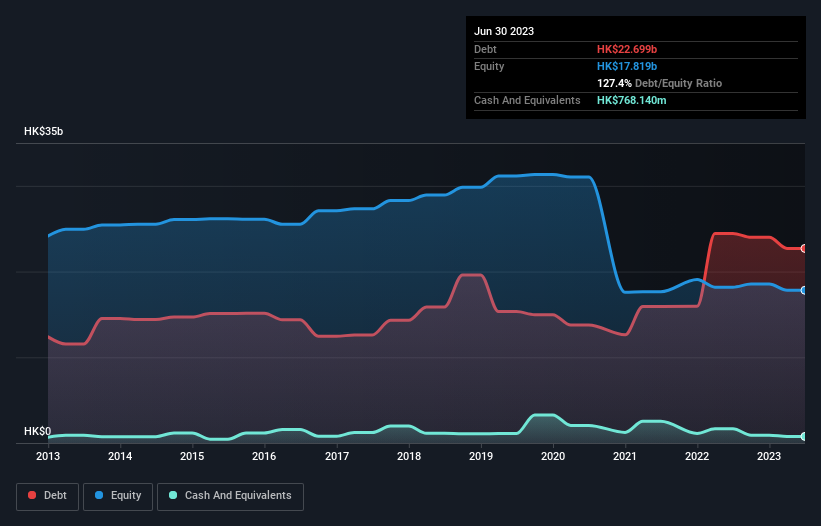Legendary fund manager Li Lu (who Charlie Munger backed) once said, 'The biggest investment risk is not the volatility of prices, but whether you will suffer a permanent loss of capital.' When we think about how risky a company is, we always like to look at its use of debt, since debt overload can lead to ruin. Importantly, Kowloon Development Company Limited (HKG:34) does carry debt. But should shareholders be worried about its use of debt?
Why Does Debt Bring Risk?
Debt and other liabilities become risky for a business when it cannot easily fulfill those obligations, either with free cash flow or by raising capital at an attractive price. Ultimately, if the company can't fulfill its legal obligations to repay debt, shareholders could walk away with nothing. However, a more common (but still painful) scenario is that it has to raise new equity capital at a low price, thus permanently diluting shareholders. Of course, the upside of debt is that it often represents cheap capital, especially when it replaces dilution in a company with the ability to reinvest at high rates of return. When we think about a company's use of debt, we first look at cash and debt together.
See our latest analysis for Kowloon Development
What Is Kowloon Development's Debt?
The image below, which you can click on for greater detail, shows that Kowloon Development had debt of HK$22.7b at the end of June 2023, a reduction from HK$24.5b over a year. However, because it has a cash reserve of HK$768.1m, its net debt is less, at about HK$21.9b.

How Healthy Is Kowloon Development's Balance Sheet?
The latest balance sheet data shows that Kowloon Development had liabilities of HK$26.2b due within a year, and liabilities of HK$3.13b falling due after that. Offsetting this, it had HK$768.1m in cash and HK$895.2m in receivables that were due within 12 months. So it has liabilities totalling HK$27.7b more than its cash and near-term receivables, combined.
This deficit casts a shadow over the HK$7.77b company, like a colossus towering over mere mortals. So we definitely think shareholders need to watch this one closely. At the end of the day, Kowloon Development would probably need a major re-capitalization if its creditors were to demand repayment.
We measure a company's debt load relative to its earnings power by looking at its net debt divided by its earnings before interest, tax, depreciation, and amortization (EBITDA) and by calculating how easily its earnings before interest and tax (EBIT) cover its interest expense (interest cover). Thus we consider debt relative to earnings both with and without depreciation and amortization expenses.
As it happens Kowloon Development has a fairly concerning net debt to EBITDA ratio of 11.4 but very strong interest coverage of 11.1. This means that unless the company has access to very cheap debt, that interest expense will likely grow in the future. Notably, Kowloon Development's EBIT launched higher than Elon Musk, gaining a whopping 238% on last year. When analysing debt levels, the balance sheet is the obvious place to start. But you can't view debt in total isolation; since Kowloon Development will need earnings to service that debt. So when considering debt, it's definitely worth looking at the earnings trend. Click here for an interactive snapshot.
Finally, while the tax-man may adore accounting profits, lenders only accept cold hard cash. So we always check how much of that EBIT is translated into free cash flow. Over the last three years, Kowloon Development saw substantial negative free cash flow, in total. While investors are no doubt expecting a reversal of that situation in due course, it clearly does mean its use of debt is more risky.
Our View
On the face of it, Kowloon Development's conversion of EBIT to free cash flow left us tentative about the stock, and its level of total liabilities was no more enticing than the one empty restaurant on the busiest night of the year. But at least it's pretty decent at growing its EBIT; that's encouraging. We're quite clear that we consider Kowloon Development to be really rather risky, as a result of its balance sheet health. For this reason we're pretty cautious about the stock, and we think shareholders should keep a close eye on its liquidity. The balance sheet is clearly the area to focus on when you are analysing debt. But ultimately, every company can contain risks that exist outside of the balance sheet. Case in point: We've spotted 3 warning signs for Kowloon Development you should be aware of, and 2 of them are significant.
If you're interested in investing in businesses that can grow profits without the burden of debt, then check out this free list of growing businesses that have net cash on the balance sheet.
Valuation is complex, but we're here to simplify it.
Discover if Kowloon Development might be undervalued or overvalued with our detailed analysis, featuring fair value estimates, potential risks, dividends, insider trades, and its financial condition.
Access Free AnalysisHave feedback on this article? Concerned about the content? Get in touch with us directly. Alternatively, email editorial-team (at) simplywallst.com.
This article by Simply Wall St is general in nature. We provide commentary based on historical data and analyst forecasts only using an unbiased methodology and our articles are not intended to be financial advice. It does not constitute a recommendation to buy or sell any stock, and does not take account of your objectives, or your financial situation. We aim to bring you long-term focused analysis driven by fundamental data. Note that our analysis may not factor in the latest price-sensitive company announcements or qualitative material. Simply Wall St has no position in any stocks mentioned.
About SEHK:34
Kowloon Development
An investment holding company, engages in the investment, development, and management of properties in Hong Kong and Mainland China.
Moderate risk with mediocre balance sheet.
Similar Companies
Market Insights
Community Narratives



